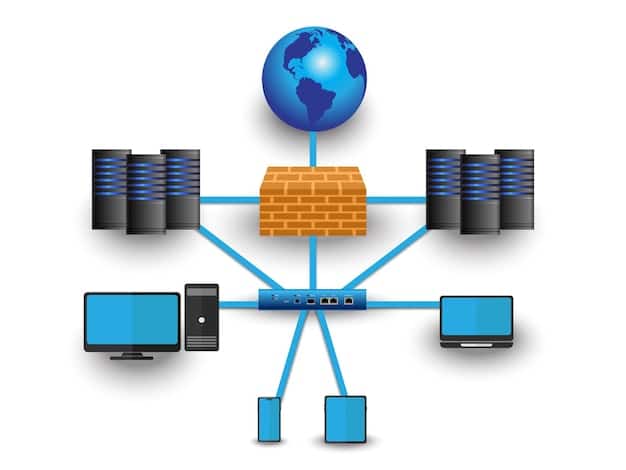Network Segmentation: A Cybersecurity Guide for Enhanced Security

Network segmentation divides a network into smaller, more manageable segments, enhancing security by isolating critical assets and limiting the impact of potential cyberattacks, thus providing a robust defense strategy.
In today’s digital landscape, cybersecurity threats are constantly evolving. One effective strategy for protecting your network is network segmentation, a technique that divides your network into smaller, isolated segments reducing the reach for potential cyberattacks.
Understanding network segmentation
Network segmentation involves dividing a network into smaller, isolated segments or subnetworks. This approach enhances security and improves network performance by controlling traffic flow and limiting the impact of security breaches. Each segment can be configured with its own security policies, access controls, and monitoring mechanisms.
Why segment your network?
Segmenting your network provides several important benefits, including reduced attack surface, that limits damage from breaches and simplified compliance. These advantages are essential for maintaining a robust security posture.
Key benefits of segmentation
Segmentation offers a range of advantages for organizations looking to bolster their cybersecurity defenses and enhance overall network management:
- Improved Security: Isolating sensitive data and critical assets reduces the risk of lateral movement by attackers, minimizing the impact of potential breaches.
- Enhanced Compliance: Allows organizations to apply specific security policies to different segments, simplifying compliance with industry regulations and standards.
- Reduced Attack Surface: Limiting the scope of network access reduces the number of potential entry points for attackers, making it harder for them to penetrate the network.
- Improved Network Performance: Segmenting the network can improve performance by reducing congestion and optimizing traffic flow within each segment.
Ultimately, the goal of the network segmentation is to limit risks from breaches, enable simplified security policies and manage the complexity of securing your system and data.
Types of network segmentation
Network segmentation can be implemented through various methods, each offering different levels of isolation and control. Choosing the right method depends on the specific needs and requirements of your organization.

Physical segmentation
Physical segmentation involves physically separating network segments using different hardware, such as routers, switches, and firewalls. This ensures complete isolation between segments.
Logical segmentation (VLANs)
Virtual LANs (VLANs) logically separate network segments within the same physical infrastructure. VLANs use software to create isolated broadcast domains, allowing for flexible and cost-effective segmentation.
Microsegmentation
Microsegmentation is a granular approach that isolates individual workloads or applications. It provides the highest level of security and control by applying specific security policies to each workload.
Selecting the right type of network segmentation significantly depends on cost of configuration, and other technical limitations. Weighing these concerns is essential for setting up your network effectively.
Implementing network segmentation
The implementation of network segmentation involves several key steps, from planning and design to configuration and testing. A well-structured approach ensures effective segmentation and minimal disruption to network operations.
Planning and design
Start by identifying critical assets and defining security policies for each segment. Consider regulatory requirements and compliance standards relevant to your industry.
Configuration and deployment
Configure network devices, such as routers, switches, and firewalls, to enforce segmentation policies. Deploy VLANs or microsegmentation solutions based on your chosen method.
Testing and validation
Thoroughly test the segmentation to ensure it works as intended. Validate that traffic flows correctly and that security policies are effectively enforced.
A successful network segmentation relies on careful planning and detailed configuration. Regular testing and updates are necessary to keep improving the security of your network.
Best practices for network segmentation
To maximize the effectiveness of network segmentation, follow these best practices. These guidelines help ensure that your segmentation strategy is robust, manageable, and aligned with security goals.

Define clear security policies
Establish clear and comprehensive security policies for each network segment. Define who can access what resources and what types of traffic are allowed.
Use a least privilege approach
Implement the principle of least privilege, granting users only the permissions necessary to perform their jobs. This minimizes the potential impact of compromised accounts.
Regularly monitor and update
Continuously monitor network traffic and security events to detect anomalies and potential threats. Regularly update segmentation policies to address new vulnerabilities and changing business needs.
By following these steps, organizations can enhance their security posture, reduce compliance burdens, and improve overall network performance. Regular monitoring and updates are essential to maintaining a secure and efficient network environment.
Tools for network segmentation
Several tools and technologies can assist in implementing and managing network segmentation. These tools provide visibility, control, and automation, making it easier to enforce security policies and monitor network traffic.
Firewalls
Firewalls are essential for enforcing segmentation policies and controlling traffic flow between segments. Next-generation firewalls (NGFWs) offer advanced features such as intrusion detection and prevention.
VLAN management
VLAN management tools help you create, configure, and manage VLANs for logical segmentation. These tools simplify VLAN administration and ensure consistent policies across the network.
Microsegmentation solutions
Microsegmentation solutions offer granular control over network traffic and security policies at the workload level. These solutions provide advanced features such as automated policy enforcement and real-time monitoring.
Choosing the right equipment can significantly streamline the segmentation process. These tools can reduce risk and compliance burdens, leading to a more reliable and secure network infrastructure.
The future of network segmentation
Network segmentation will continue to evolve as organizations adopt new technologies and face emerging threats. Future trends include increased automation, integration with cloud environments, and adoption of software-defined networking (SDN).
Automation
Automation will play a bigger role in network segmentation, automating policy enforcement, threat detection, and incident response. This reduces the administrative overhead and improves security posture.
Cloud integration
Integrating network segmentation with cloud environments is crucial for protecting cloud-based assets and data. Cloud-native segmentation solutions provide consistent security policies across on-premises and cloud environments.
Software-defined networking (SDN)
SDN enables dynamic and flexible network segmentation through software control. SDN simplifies network management and allows organizations to quickly adapt to changing business needs and security threats.
The future of the network segmentation will evolve, adapting to changing technologies and focusing on automation and real-time data to increase security. Adopting SDN-based approaches allows for greater flexibility and greater scaling options.
| Key Point | Brief Description |
|---|---|
| 🛡️ Improved Security | Isolating sensitive data reduces lateral movement and minimizes breach impact. |
| ✅ Enhanced Compliance | Simplifies adherence to regulatory standards with specific policies per segment. |
| 📉 Reduced Attack Surface | Limits entry points for attackers, making network penetration more difficult. |
| 🚀 Improved Performance | Enhances network speed by reducing congestion. |
FAQ
▼
The main goal is to minimize the impact of security breaches by isolating sensitive data and critical assets. This prevents attackers from moving laterally across the network.
▼
Common types include physical segmentation, VLANs (Virtual LANs), and microsegmentation. Each type offers different levels of isolation and control.
▼
Microsegmentation provides more granular control by isolating individual workloads or applications, whereas VLANs segment networks into broader logical divisions.
▼
Continuous monitoring helps detect anomalies and potential threats in real-time, ensuring that segmentation policies are effectively enforced and updated as needed.
▼
Yes, it simplifies compliance by allowing organizations to apply specific security policies to different segments, aligning with industry regulations and standards more effectively.
Conclusion
Network segmentation is a crucial cybersecurity strategy for protecting your network from modern threats. By dividing your network into smaller, isolated segments, you can reduce the attack surface, limit the impact of breaches, and improve overall security posture. Implementing best practices, using the right tools, and staying updated with emerging trends are essential for maximizing the effectiveness of network segmentation.





